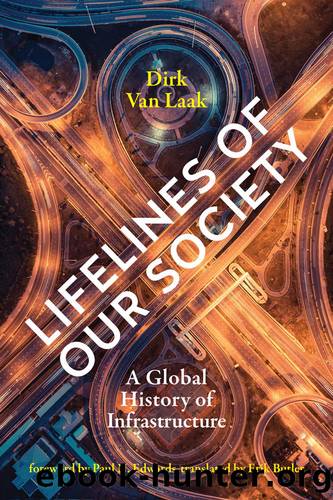Lifelines of Our Society by Dirk Van Laak

Author:Dirk Van Laak
Language: eng
Format: epub
Publisher: MIT Press
ACTIVE PUBLIC SPIRIT
On July 5, 1942, the Japanese military placed a zero kilometer marker in Nong Pladuk, Siam. The town, two hours west of Bangkok, was to be the starting point for a railway between the Gulf of Siam and the Indian Ocean; the other end would lie 415 kilometers away in Thanbyuzayat, Burma. Building the line would enable the Japanese to avoid the sea route around the Malay Peninsula, which was especially perilous in wartime, and facilitate military attack on British India. Some sixty thousand British, Dutch, American, and Australian prisoners of war performed the work. Further contributions came from almost two hundred thousand forced laborers, including Japanese soldiers who had lost their honor after desertion or other offenses. Track material was brought from conquered territories known, in the aggregate, as the Greater East Asian Sphere of Prosperityâa designation comparable to the contemporaneous Greater Germanic Empire in Europe, half a world away.
Construction proceeded at a ruthless pace, and the line could be traveled by December 1943. Western prisoners called the Thailand-Burma line the Death Railway.36 Each crosstie was said to have cost a human life; over one hundred thousand Asians and twelve thousand Allied prisoners died in the course of the project. Many of the 688 bridges along the way crossed the Khwae Yai River, one of which provided the setting for The Bridge on the River Kwai (1957), a film decorated with multiple Oscars. The ultranationalist Yasukuni Shrine in Tokyo still houses the first locomotive to have made the journey. After the war, the Thai government had to rebuild almost the entire line. The forced laborers had shown little concern for quality; indeed, they had done poor work on purpose so the railway would not operate for long.37
Few infrastructures built under duress have received as much attention as the Death Railway, but using forced labor for transportation projects was widespread practice. Detailed figures are unavailable, but according to Congolese lore, for example, the construction of the Matadi-Léopoldville railway in the 1890s came at a terrible cost; âevery railroad tie represents the life of an African, every telegraph pole that of a European.â38 The British explorer Henry Morton Stanley summed up the reasoning behind such undertakings: African countries without a railroad are not worth two shillings; with one, however, their value defies calculation.39
Particularly onerous tasks were often performed by prisoners of war or inmates of concentration camps. Work included draining swamps, digging canals for irrigation or drainage, quarrying stones, and constructing roads.40 All work was difficult and thankless; the humanitarian provisions of international law, which sought to restrict such practices beginning in the late nineteenth century, went largely unheeded. Forced labor was justified by the general benefit it was supposed to provide; moreover, the claim went, hard work had educational and morally cleansing virtues.
4.2â â â Forced labor was used for the âcommon good.â Here, prisoners build rails at Buchenwald, spring 1943. United States Holocaust Memorial Museum, courtesy of Gedenkstaette Buchenwald.
Download
This site does not store any files on its server. We only index and link to content provided by other sites. Please contact the content providers to delete copyright contents if any and email us, we'll remove relevant links or contents immediately.
Bad Blood by John Carreyrou(6555)
Rich Dad Poor Dad by Robert T. Kiyosaki(6413)
Principles: Life and Work by Ray Dalio(6220)
Playing to Win_ How Strategy Really Works by A.G. Lafley & Roger L. Martin(5931)
Management Strategies for the Cloud Revolution: How Cloud Computing Is Transforming Business and Why You Can't Afford to Be Left Behind by Charles Babcock(4528)
The Confidence Code by Katty Kay(4189)
Thinking in Bets by Annie Duke(4154)
American Kingpin by Nick Bilton(3759)
Delivering Happiness by Tony Hsieh(3369)
Project Animal Farm: An Accidental Journey into the Secret World of Farming and the Truth About Our Food by Sonia Faruqi(3178)
The Power of Habit by Charles Duhigg(3062)
The Tyranny of Metrics by Jerry Z. Muller(3003)
Brotopia by Emily Chang(3001)
Mastering Bitcoin: Programming the Open Blockchain by Andreas M. Antonopoulos(2981)
The Marketing Plan Handbook: Develop Big-Picture Marketing Plans for Pennies on the Dollar by Robert W. Bly(2977)
I Live in the Future & Here's How It Works by Nick Bilton(2938)
The Content Trap by Bharat Anand(2863)
Building a StoryBrand by Donald Miller(2843)
Applied Empathy by Michael Ventura(2839)
